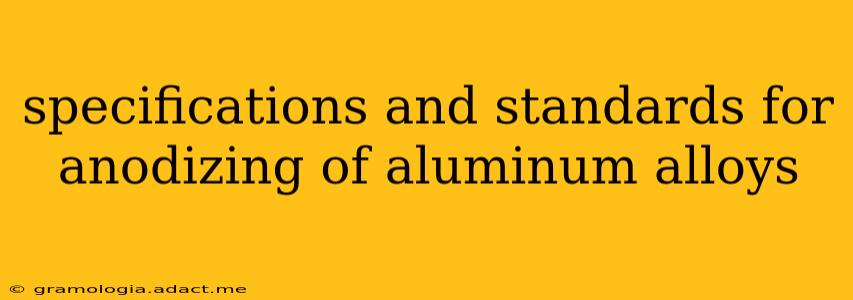Anodizing aluminum is a crucial process that enhances its durability, corrosion resistance, and aesthetic appeal. Understanding the specifications and standards governing this process is vital for ensuring consistent quality and meeting industry requirements. This comprehensive guide delves into the key aspects of anodizing aluminum alloys, addressing common questions and providing insights into the various standards employed globally.
What are the different types of anodizing processes?
Several anodizing processes exist, each offering unique properties:
-
Chromic Acid Anodizing: This process produces a thin, hard, and corrosion-resistant coating, often preferred for its excellent sealing properties. It's typically used for applications requiring high corrosion resistance and where a thinner coating is desirable.
-
Sulfuric Acid Anodizing: The most common type, sulfuric acid anodizing creates a thicker, more porous coating, ideal for applications requiring dyeing or painting. The thicker coating provides better abrasion resistance compared to chromic acid anodizing.
-
Hard Anodizing: This process creates a significantly thicker and harder coating than conventional anodizing, offering superior wear and abrasion resistance. It's often used for components subjected to high wear and tear, such as aerospace parts or industrial machinery components.
What are the common standards for anodizing aluminum?
Several national and international standards define the requirements for anodizing aluminum alloys. These standards cover aspects like coating thickness, corrosion resistance, and color uniformity. Key standards include:
-
ASTM B580: This American standard covers the anodizing of aluminum and aluminum alloys. It specifies requirements for the process, coating properties, and testing methods.
-
MIL-A-8625 (Obsolete): While obsolete, this former military standard is still referenced in some legacy documents. It provides stringent requirements for anodizing aluminum used in military applications. Referencing current standards is highly recommended.
-
ISO 9001: While not specific to anodizing, ISO 9001 is a widely recognized quality management system standard that many anodizing facilities adhere to, ensuring consistent quality control throughout the process. It's crucial to ensure the anodizer is certified to this standard or an equivalent.
What are the typical coating thicknesses for different anodizing processes?
Coating thickness varies depending on the anodizing process and the desired properties:
-
Chromic Acid Anodizing: Typically ranges from 0.5 to 2 µm (micrometers).
-
Sulfuric Acid Anodizing: Usually ranges from 5 to 25 µm.
-
Hard Anodizing: Can reach thicknesses of 25 µm to 100 µm or more, depending on the application's requirements.
How is the quality of anodizing measured?
The quality of anodizing is assessed through several methods:
-
Coating Thickness Measurement: Microscopic examination or other non-destructive testing methods are used to measure the thickness of the anodic coating.
-
Corrosion Resistance Testing: Salt spray testing (ASTM B117) is a common method to evaluate the coating's ability to resist corrosion.
-
Adhesion Testing: Tests evaluate the bond strength between the anodic coating and the aluminum substrate.
What aluminum alloys are commonly anodized?
Various aluminum alloys are suitable for anodizing, each exhibiting different properties and suitability for specific applications. Common alloys include:
-
6061: A versatile alloy often used in architectural applications and transportation.
-
6063: Commonly used for extrusion profiles and architectural applications.
-
5052: Known for its high corrosion resistance, making it suitable for marine environments.
What are the typical applications of anodized aluminum?
Anodized aluminum finds widespread use across diverse industries:
-
Aerospace: Components requiring high strength, corrosion resistance, and wear resistance.
-
Automotive: Exterior and interior trim, wheels, and other components.
-
Architectural: Building facades, window frames, and other exterior elements.
This overview provides a foundation for understanding the specifications and standards relevant to anodizing aluminum alloys. Remember that specific requirements may vary based on the application and the desired properties of the finished product. Consulting with an experienced anodizer and referencing the latest versions of relevant standards are crucial for successful project implementation.
